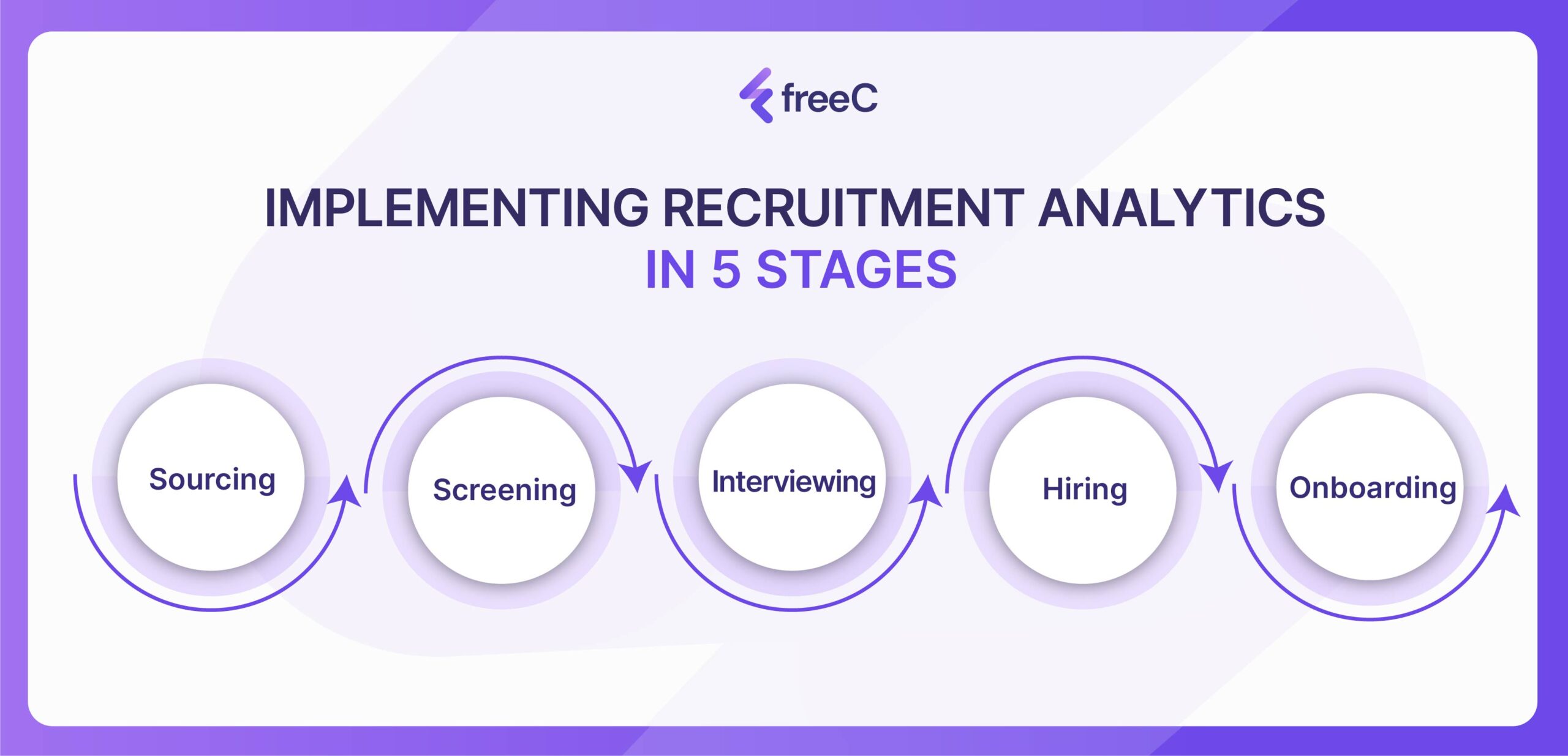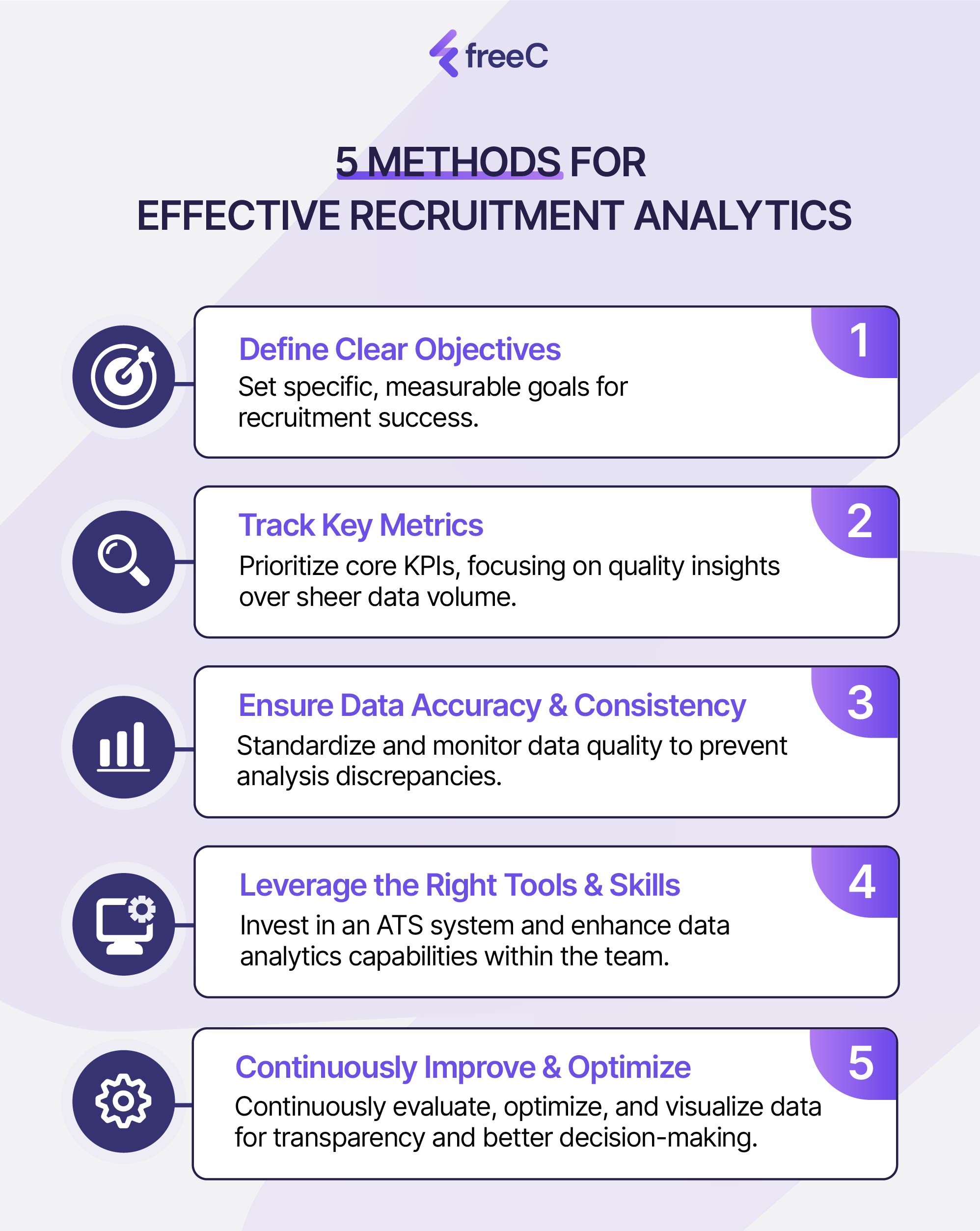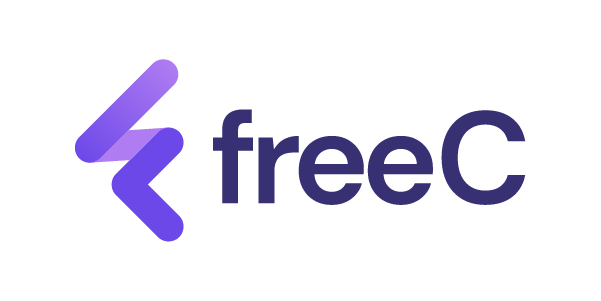Are you feeling uncertain and overwhelmed by key recruitment data?
This article will help you unlock the power of recruitment analytics, offering best practices, practical insights, and data-driven strategies to enhance your hiring process effectively.
Join freeC Asia in exploring how to make smarter hiring decisions and achieve better recruitment outcomes!
What is Recruitment Analytics?
Recruitment analytics, sometimes called talent analytics or HR analytics (when applied to hiring), is all about using data to make smarter, more effective hiring decisions. Think of it like this: instead of relying on gut feelings, you’re using facts and figures to understand every step of your recruitment process.
It involves sourcing, analyzing, and interpreting data related to everything from where your best candidates are coming from to how long it takes to fill a position, and even how well those new hires perform.
It’s not just about collecting a bunch of numbers, though. The real magic happens when you turn that data into actionable insights – things you can actually use to improve your hiring process, save money, and build a stronger team.
Basically, recruitment analytics helps you answer questions like:
- Are we spending our recruiting budget wisely?
- Which sources give us the best quality hires?
- How can we make the hiring process faster and smoother for everyone involved?
Recruitment Analytics: Key Reasons!
Recruitment analytics is no longer optional, it’s a must-have for organizations aiming to attract and retain top talent effectively. It provides data-driven insights to optimize hiring strategies, moving businesses from reactive to proactive recruitment.
Right Talent, Right Time
Identify the best hiring channels (job boards, referrals, social media) to attract top candidates. Optimize job descriptions and interviews to ensure cultural and role fit.
Data-Driven Decisions
Track key metrics like time-to-hire, cost-per-hire, and offer acceptance rates to eliminate bottlenecks and improve decision-making.
Boost Hiring Efficiency
Spot inefficiencies (e.g., slow screening, delayed responses) and leverage AI to streamline workflows, reducing hiring time.
Enhance Candidate Experience
Remove friction points like complex application processes or slow feedback. A smooth experience strengthens employer branding and attracts top talent.
Reduce Turnover
Hire the right fit from the start. Analytics help assess onboarding effectiveness and identify turnover causes, ensuring long-term employee retention.
Optimize Hiring Budget
No more guesswork—understand your ideal candidate’s skills, experience, and traits. Craft precise job descriptions and targeted hiring campaigns for better ROI.
A quick glance at the evolution of Recruitment Analytics
Recruitment has come a long way. Before the internet, finding candidates relied on newspaper ads, job boards, and word-of-mouth referrals – methods that were slow and often inefficient. Even after the rise of online platforms, the recruitment industry was initially slow to fully utilize the potential of data.
Today, intelligent recruitment analytics tools offer a fast, efficient, and incredibly precise way to analyze every aspect of the hiring process. They allows us to generate data-driven forecasts – predicting the hiring metrics, and even how a new hire will perform on the job.
Laying the foundation for Recruitment Analytics Success
Initially, it’s crucial to set yourself up for success before jump in. You can’t just start collecting random data and expect magic to happen. The key is to choose the right recruitment analytics tools and make sure they fit your needs. Here’s some principles for you to keep in mind:
| Track the right metrics | Display data comprehensively | Suitability is key | Perform broad integration |
| Make sure the tools you choose can actually track the metrics that matter most to your company.
Think about what you really need to measure to improve your hiring (e.g., time-to-fill, source of hire, quality of hire). |
Choose tools that present information in a clear, visual way – dashboards, charts, and reports that make it easy to spot trends and insights at a glance. | You should choose software that matches the technical skills of everyone on your team, from recruiters to hiring managers.
Simple and intuitive is the goal. |
Make sure the tools you choose can integrate seamlessly with your other HR systems, like your Applicant Tracking System (ATS) and HRIS.
This avoids data silos and ensures a smooth flow of information. |
Key Recruitment Metrics: Stage-by-Stage Breakdown
Recruitment success isn’t about tracking every metrics – it’s about measuring the right ones at each stage to drive better hiring decisions.

By structuring recruitment into five key stages: Sourcing, Screening, Interviewing, Hiring, and Onboarding, you can pinpoint inefficiencies, optimize processes, and improve hiring outcomes.
1. Sourcing Stage – Where do your best candidates come from?
Tracking sourcing metrics helps assess the effectiveness of recruitment channels and job postings, ensuring an efficient use of resources.
Key Metrics:
- Source of Hire: Identifies the most effective channels.
- Application Completion Rate: Measures candidate engagement with job postings.
2. Screening Stage – Are you filtering efficiently?
A strong screening process ensures that only the best-fit candidates move forward, reducing wasted interview time.
Key Metrics:
- Screening-to-Interview Rate: Evaluates the effectiveness of initial filters.
- Candidate Assessment Scores: Helps quantify candidate quality.
3. Interviewing Stage – Is your process selecting the right talent?
Tracking interview metrics helps refine assessment methods and alignment among hiring teams.
Key Metrics:
- Interview-to-Offer Ratio: Indicates how well interviews identify top candidates.
- Interviewer Feedback Consistency: Measures alignment in candidate evaluations.
4. Hiring Stage – Are you closing the right candidates quickly?
Efficiency at this stage impacts both business productivity and candidate experience.
Key Metrics:
- Time-to-Fill: Tracks hiring speed and process efficiency.
- Offer Acceptance Rate: Reflects the competitiveness of offers and candidate experience.
5. Onboarding Stage – Do new hires succeed and stay?
Onboarding metrics provide insight into long-term hiring success and retention.
Key Metrics:
- Early Turnover Rate (within 90 days): Indicates retention challenges.
- New Hire Performance: Assesses the effectiveness of hiring decisions.
By focusing on these stage-specific metrics, HR teams can enhance hiring efficiency, reduce costs, and secure top talent effectively.
3 levels of Recruitment Analytics
Recruitment analytics evolves through three levels, each adding more strategic value:
1. Operational Reporting (The basics)
The foundation of recruitment analytics, focusing on key hiring metrics to measure efficiency.
- Key Metrics: Time-to-fill, cost-per-hire, source of hire, hiring manager satisfaction, CVs sent, interviews booked.
- Purpose: Evaluates recruiter/team performance and hiring process effectiveness.
- Tools: Most ATS platforms track these basics.
2. Advanced Reporting (Going deeper)
Combines data sources for deeper insights into past performance.
- Key Metrics: Candidate experience, sourcing channel effectiveness, cost per candidate per channel.
- Purpose: Highlights strengths, weaknesses, and areas for optimization.
- Tools: Requires ATS integration, surveys, and HR systems.
3. Strategic & Predictive Analytics (The future View)
Uses statistical models and AI to predict and optimize recruitment outcomes.
- Key Metrics: Predictive time-to-hire, candidate experience, A/B testing for funnel optimization.
- Purpose: Transforms data into proactive hiring strategies and competitive advantage.
- Tools: Advanced analytics platforms with AI/machine learning.
Notable challenges when executing Recruitment Analytics
While recruitment analytics offers incredible benefits, it’s not always smooth sailing. Implementing and effectively utilizing data-driven hiring strategies can come with its own set of hurdles. Being aware of these potential challenges is the first step to overcoming them. Here are some of the most common roadblocks:
- Data quality issues: Inaccurate, incomplete, or inconsistent data can lead to flawed insights and poor decisions.
- Data silos: When data is scattered across different systems (ATS, HRIS, spreadsheets) and doesn’t “talk” to each other, it’s difficult to get a holistic view.
- Lack of data literacy: If your team doesn’t understand how to interpret and apply data, even the best tools won’t be helpful.
- Choosing the right tools: Selecting the wrong analytics platform or software can be a costly mistake, leading to frustration and wasted resources.
- Resistance to change: Some team members may be resistant to adopting new processes or relying on data instead of intuition.
- Over-reliance on metrics: Focusing solely on numbers without considering the human element of recruitment can lead to unintended consequences.
- Privacy and compliance: Ensuring you are handling candidate and employee data ethically and legally is crucial, avoid committing to privacy regulations (like GDPR).
5 Key Methods for Effective Recruitment Analytics
Set Clear Objective
Define specific, measurable goals before diving into data. Focus on key outcomes like reducing time-to-fill, improving hire quality, or optimizing recruitment costs.
Track Relevant Metrics
Prioritize essential KPIs that align with your goals rather than tracking excessive data. Quality over quantity ensures meaningful insights.
Ensure Data Accuracy & Integrity
Maintain clean, consistent, and reliable data to prevent misleading analysis. Implement strict data validation and governance processes.
Leverage the Right Tools & Skills
Invest in an intuitive ATS and analytics platforms while fostering data literacy within your team to ensure insights are correctly interpreted and applied.
Adopt a Continuous Improvement Approach
Regularly review, refine, and iterate your recruitment strategies based on data insights. Communicate findings effectively using visuals and ensure ethical data handling.

Recruitment Analytics: The Ultimate Headhunting Service for Effective Hiring
Tracking and analyzing recruitment data not only speeds up hiring but also builds a sustainable talent strategy.
freeC Asia provides intelligent Headhunting solutions, empowering businesses to leverage Recruitment Analytics for optimized hiring processes.
Smart Recruitment Data – Hire the Right Talent, Fast
- AI-driven technology helps businesses connect with the right candidates in the shortest time.
- Analyze hiring trends, measure recruitment channel effectiveness, and optimize talent sourcing.
Talent Market Insights – Understand and Retain Top Talent
- Forecast workforce trends to support long-term HR planning.
- Access real-time salary and benefits data to craft competitive and attractive compensation policies.
Optimized Recruitment Process – Minimize Risks, Maximize Efficiency
- Reduce time-to-hire by up to 40% with data-driven recruitment strategies.
- Track and evaluate hiring performance at every stage, enabling faster and more accurate decision-making.
Let freeC Asia be your trusted partner in shaping your talent strategy. Contact us now for a free consultation!









